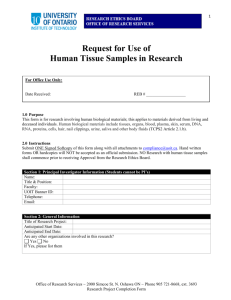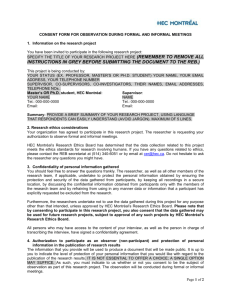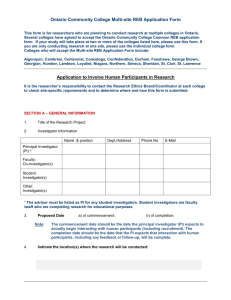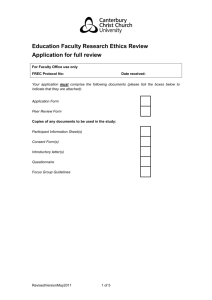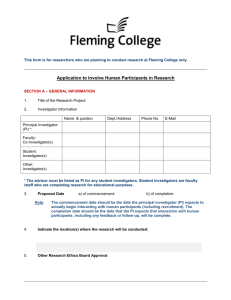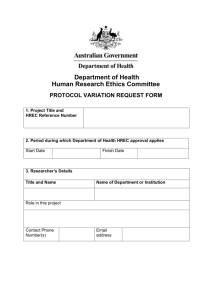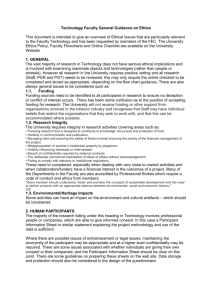application for ethical review
advertisement
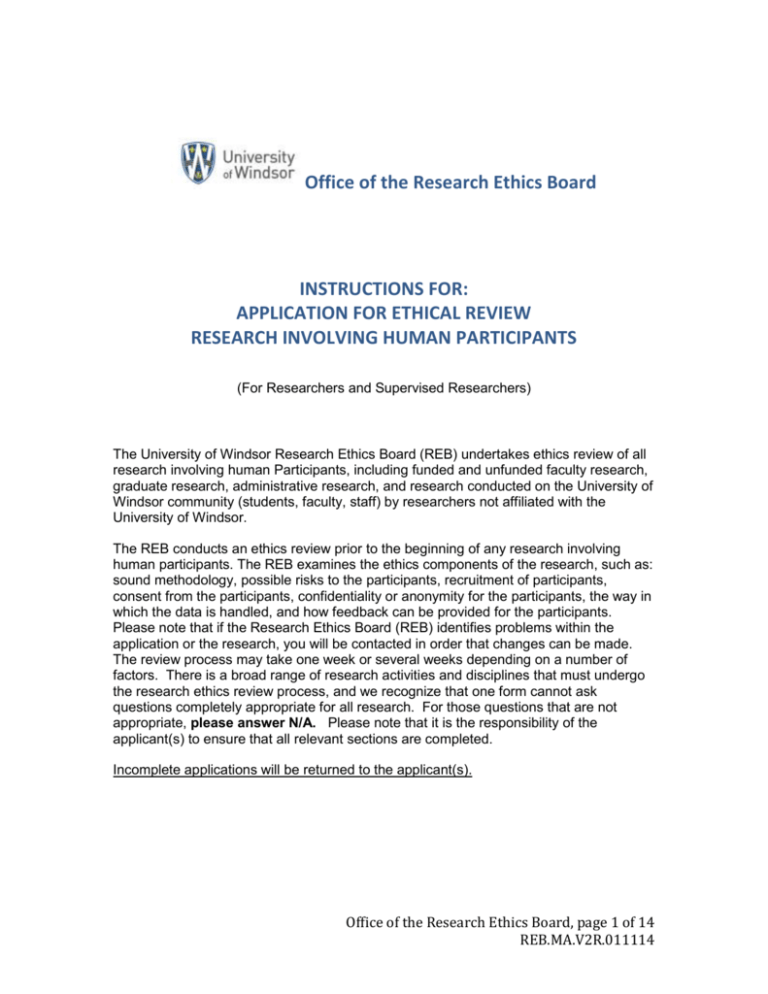
Office of the Research Ethics Board INSTRUCTIONS FOR: APPLICATION FOR ETHICAL REVIEW RESEARCH INVOLVING HUMAN PARTICIPANTS (For Researchers and Supervised Researchers) The University of Windsor Research Ethics Board (REB) undertakes ethics review of all research involving human Participants, including funded and unfunded faculty research, graduate research, administrative research, and research conducted on the University of Windsor community (students, faculty, staff) by researchers not affiliated with the University of Windsor. The REB conducts an ethics review prior to the beginning of any research involving human participants. The REB examines the ethics components of the research, such as: sound methodology, possible risks to the participants, recruitment of participants, consent from the participants, confidentiality or anonymity for the participants, the way in which the data is handled, and how feedback can be provided for the participants. Please note that if the Research Ethics Board (REB) identifies problems within the application or the research, you will be contacted in order that changes can be made. The review process may take one week or several weeks depending on a number of factors. There is a broad range of research activities and disciplines that must undergo the research ethics review process, and we recognize that one form cannot ask questions completely appropriate for all research. For those questions that are not appropriate, please answer N/A. Please note that it is the responsibility of the applicant(s) to ensure that all relevant sections are completed. Incomplete applications will be returned to the applicant(s). Office of the Research Ethics Board, page 1 of 14 REB.MA.V2R.011114 SECTION A – PROJECT OVERVIEW TITLE OF THE RESEARCH PROJECT For funded research, please ensure that the title is the same as that of the grant application. Where more than one ethics protocol is required to cover the research of a specific project, please use the title plus subtitle or other form of identification. PROJECT START AND END DATES Project start and end dates can be interpreted in several ways. In some traditions, engagement with the participant group may start before the beginning of data collection, and end significantly later than the end of data collection. Therefore, the start date should refer to the beginning of a formal recruitment process, or, in the case where there is no formal process, the commencement of the informed consent process and data collection. Completion of a study can be defined as the point in which data analysis has been completed in order to answer the original research question(s). BRIEF JUSTIFICATION Researchers are asked to provide a rationale as to the level of review that is appropriate for the project. In presenting the justification, the level of risk associated with the group(s) to be studied and the specific methods should be noted in sufficient detail to aid the board in determining the level of review that is proportionate to the risks associated with the project. SECTION B – GENERAL INFORMATION 1., 2. INVESTIGATOR INFORMATION The Principal Investigator is the researcher who assumes primary responsibility for conduct of the research. This may not be the same researcher who serves as PI on the grant, nor the PI on the overarching project, if it is multi-centered. In the case of graduate student research, if the project will serve as the thesis or degree-fulfilling requirement, the graduate student will normally be the PI. Post-doctoral fellows and Visiting Professors may serve as PI on the ethics protocol. However, in these cases, a faculty member must sign as the “Faculty Sponsor” of the project. The Faculty Sponsor, like the Faculty Supervisor, takes responsibility for ensuring that the PI conducts the research project ethically, in accordance with the REBapproved protocol. Undergraduate course-based research should be reviewed by the appropriate Delegated Ethics Review Committee (typically departmental ethics committees), unless the Office of the Research Ethics Board, page 2 of 14 REB.MA.V2R.011114 research is funded or entails more than minimal risk. Please see your department or faculty Undergraduate Coordinator to determine what this process entails. Projects from departments that do not have undergraduate committees are sent to the REB. 3. LOCATION(S) WHERE THE RESEARCH WILL BE CONDUCTED: If the research is to be conducted at a site requiring administrative approval/consent (e.g. in a school), please include all draft administrative approval/consent letters. It is the responsibility of the researcher to determine what other means of approval are required, and to obtain approval prior to starting the project. If you are unsure, please contact the office of the REB. Field research outside of Canada normally requires ethics review by a board or committee within that jurisdiction. Please see http://www.hhs.gov/ohrp/international/ to determine what process is in place in the country where the research is to take place. In cases where there is no ethics review process, a letter by a relevant body (e.g. NGO, University) stating that there is no ethics review process that covers the participants but that the research is culturally and ethically acceptable is required. In situations where authorities’ knowledge of the research to be conducted could potentially put the researcher and/or the participants in danger, it may be preferable not to seek administrative consent. Please explain these circumstances in the protocol submission form. 4. OTHER RESEARCH ETHICS BOARD APPROVAL Please indicate all research sites and additional ethics reviews. This may include other institutions/sites that are collaborating in the research, and/or other institution/sites where the research will be conducted. 5. FUNDING OF THE PROJECT It is common for one protocol to cover several grants. Please make sure to include all agency and known funding information that the protocol will be covering. It is also common for one grant to fund several research projects, each of which is/will be covered by a separate ethics protocol. Please provide the number of protocols they anticipate will be submitted in order to cover the entire funded research activity, and to specify that this is # X of total number. If funding changes (e.g. addition of sponsor, deletion of sponsor, change of sponsor) during the course of research, an amendment should be submitted to the ERO to state this. Scholarships and fellowships are not relevant to this section unless there is a research allowance component that involves human participants. Please note, the REB requires the exact title under which funding was approved. Office of the Research Ethics Board, page 3 of 14 REB.MA.V2R.011114 6. CONTRACTS If there is a funding or non-funded agreement associated with the research, please submit one copy of the contract to the REB along with the ethics protocol. 7. REB REVIEW OF ONGOING RESEARCH As a Canadian research institution, the University of Windsor is in compliance with TriCouncil Policy Statement 2 (TCPS2). According to Article 6.14 of the TCPS2: “The REB shall make the final determination as to the nature and frequency of continuing research ethics review in accordance with a proportionate approach to research ethics review. At minimum, continuing research ethics review shall consist of an annual status report (for multi-year research projects), and an end-ofstudy report (projects lasting less than one year).” Therefore, at the minimum, researchers wanting to continue with a project beyond the expiry date of their current ethics approval (normally valid for one year, dependent on the REB’s evaluation of risk level) are required to submit an Annual Progress Report. A study is considered to be ongoing until data analysis is complete. A Study Final Report must be submitted once the study is closed. 8. SCHOLARLY REVIEW The REB’s mandate is to ensure that the rights of research participants are protected. The principle of proportionate review entails that ”In keeping with a proportionate approach to research ethics review, the selection of the level of REB review shall be determined by the level of foreseeable risk to participants: the lower the level of risk, the lower the level of scrutiny (delegated review); the higher the level of risk, the higher the level of scrutiny (full board review).” (TCPS2) Generally this implies that different levels of REB review for different research proposals. Necessarily implied in this is that research proposals being reviewed by the delegated expedited review or by executive review may be reviewed by scholars from fields other than that of the research team. Article 16.12 of the TCPS2 states that the REB “shall satisfy itself that the design of a research project that poses more than minimal risk is capable of addressing the questions being asked in the research.” The REB, in cases where scholarly review is necessary, will be concerned with an assessment of the degree to which the research might further the understanding of a phenomenon. Article 2.7 of the TCPS2 states: “ As part of the ethics review, the REB shall review the ethical implications of the methods and design [emphasis added] of the research. Office of the Research Ethics Board, page 4 of 14 REB.MA.V2R.011114 On the assumption that good research is ethical research, the REB is encouraging researchers to view the ethics review as another opportunity to have one’s research vetted by colleagues. In its review, the REB may make collegial suggestions that are simply intended to aid the researcher. It is the goal of the REB that researchers will see the review process as another opportunity to have colleagues examine one’s research. It should be stressed that REB reviews are considered confidential and will not be disclosed. 9. CONFLICTS OF INTEREST/DUAL ROLES Any relationships that have the potential to impact recruitment, consent, or the conducted of the research should be described here and how they are managed described under Section 17/18 (Risks). See: Senate Policy C1: Conflict of Interest of Commitment Windsor University Faculty Association Collective Agreement Articles 35 and 60. TCPS 2: “Chapter 7”. SECTION C – SUMMARY OF THE PROPOSED RESEARCH 10. RATIONALE This section should be clear, concise, and provide just enough information to give the reviewers an understanding of why the research is being proposed, and what research has been done in this area. Situating the research in this way aids the REB in evaluating the ethical components of the research, including an assessment of risk. It should be assumed that the REB is familiar with the discipline, but may not be knowledgeable of the specific research area being proposed. In general lengthy literature and thesis proposals are not appropriate. 11. METHODS This section should include all methods to be used in the study, with respect to human participants and biological materials. This begins with a description of the procedure(s) to be followed, presented in a step by step fashion. Tables, figures and timelines may be useful when the study is complex or uses multiple methodologies. It is not necessary to describe standard tests or procedures (e.g. DNA analysis, MRI scans, Beck’s Depression Inventory, etc.). All measures/instruments/equipment/etc. used must be described in sufficient detail that their purpose is clear, and relevance to the project is evident. It is the responsibility of the researcher to obtain the proper permission to use certain standard instruments in their research. If this is necessary, please ensure that this is done before using any such instruments in your research. In cases where publishers do not allow for instruments to be copied, it is the responsibility Office of the Research Ethics Board, page 5 of 14 REB.MA.V2R.011114 of the researcher to obtain “review only” copies or to bring the instrument to the REB for evaluation. Please include copies of non-standard tests, interview schedules, etc. For naturalistic or participant observation, describe the setting, kinds of information and interactive and observational procedures that you anticipate using. 12. DECEPTION Deception may pose additional risks, and may require consideration as to what the debriefing process should include. Deception should, whenever possible, be through omission (leaving details out), not commission (providing false descriptions). Studies involving deception require justification for the need for deception. It has been the experience of the REB that issues in the application often stem from a lack of clarity in the Methodology section. It is in the researcher’s or in the research team’s best interest to be clear about each and every method used in the project. Incomplete answers in this section may result in the application being returned to the researcher since it would be difficult for the REB reviewers to assess the project in terms of respect for human dignity, welfare of the participants, and justice. 13. PARTICIPANTS/INFORMANTS OR DATA SUBJECTS This information should help the REB to establish not only who the participants/informants will be, but also what potential vulnerabilities, if any, they may have. For personal information, this section should provide details on how the information will be extracted or collected and what it will contain. The degree of identifiability should also be discussed (e.g. names, postal codes or parts thereof, OHIP numbers, etc.). Psychology researchers making use of the Psychology Participant Pool should indicate this in this section. 14. RECRUITMENT It is understood by the REB that methods of recruitment differ by discipline, with some not having any formal recruitment whatsoever. If there are any extenuating circumstances as to why a certain method (formal or informal) is to be used, please include this in the description. Please describe all steps in the recruitment, and distinct types of recruitment that will occur. Please remember to include contact scripts (e.g., phone, email, etc.), advertisements (e.g., posters, online, flyers, newsletter, etc.), or any other mechanism being used to recruit or to introduce the study to (potential) participants. The University logo and letterhead ought to be used. Also include a statement to the effect that your study has received REB clearance (Note: The REB does not “approve” projects but grants clearance). It is understandable that in some cases the researcher, prior to the submission of the protocol, will know potential Office of the Research Ethics Board, page 6 of 14 REB.MA.V2R.011114 participants. 15. EXPERIENCE Research with human participants can only be conducted ethically when the research team’s abilities are equal to the needs and expectations of the participant. Therefore, a brief description of the research team’s experiences and/or ability to conduct the research is required. Please note that what is of interest is the experience with the specific methods used in the protocol. For example, if online surveys are being used then the research team’s experience with online surveys must be discussed. If the researcher is a student, the degree of supervision, by the faculty supervisor and/or on-site supervisor should be included. Please note: (1) the REB requires a brief description for each and every member of the research team (2) a bibliography or CV excerpt will not suffice. 16. COMPENSATION/INCENTIVE If compensation is offered, it should not provide undue influence in an individual’s decision to participate in the research, nor should it be a simple token; participants should be duly compensated for time spent participating in the study. When participants represent a particular profession, compensation per time spent may be appropriate. Justification for the amount of compensation to be offered to participants should be provided. It is expected that whenever possible, participants who withdraw will receive partial compensation. For Psychology researchers only making use of the Psychology Participant Pool particular attention must be paid to the allocation of the bonus points. The REB understands that the Psychology Participant Pool serves as an important component in the education of psychology majors. To that end and to ensure consistency, the REB requests Psychology researchers using the pool to use the following: “Participants will receive X bonus points for Y minutes of participation towards the psychology participant pool, if registered in the pool and enrolled in one or more eligible courses.” (NOTE to researchers planning to use the pool: Credit awarded per time involved in the study must coincide with current Psychology Participant Pool policy, available on the Psychology Department web page: www.uwindsor.ca/psychology; Additional compensation above bonus points must be justified and must coincide with Pool policy). Office of the Research Ethics Board, page 7 of 14 REB.MA.V2R.011114 SECTION D – DESCRIPTION OF THE RISKS AND BENFITS 17. POSSIBLE RISKS In order to assist researchers in evaluating possible risks of harm for participants, these have been separated into types of risk: physical, psychological/emotional, social, dual/multiple relationship, data security, and deception. Deception may pose additional risks, and may require consideration as to what the debriefing process should include. Deception should, whenever possible, be through omission (leaving details out), not commission (providing false descriptions). If the research does involve greater than minimal risk, it is important for the researcher to contemplate the best way to manage or minimize it. 18. USING THE RISK MATRIX The risk matrix should be understood as a broad heuristic to help researchers frame risk factors for standard research ethics issues such as free and informed consent, privacy and confidentiality, and inclusion-exclusion criteria, as well as any special considerations such as relevant professional qualifications of the research team members. By locating a protocol on the matrix, researchers can determine both the review type (i.e. delegated expedited or full) and level of continuing review (e.g. annual renewal or small possibility of site visit) appropriate to a project. Determining Risk Level and Review Type To evaluate risk for a protocol, consider: 1. Group vulnerability—i.e., any pre-existing vulnerabilities associated with proposed participant groups, e.g., relating to pre-existing physiological or health conditions, cognitive or emotional factors, and socio-economic or legal status. Researchers are reminded that group vulnerability may be inherent (e.g., young children, members of the military, prisoners), or be tied to the specific procedures used in the research. In the former, there is a ‘main effect’ of vulnerability on the conduct the research. In the latter, the vulnerability of the group is contingent on the type of research being conducted (the group would not be vulnerable if a different type of research were to occur). 2. Research risk—i.e., the probability and magnitude of harms participants may experience as a result of the proposed methods to be used and types of data to be collected, e.g., relating to physiological or health issues such as clinical diagnoses or side effects, cognitive or emotional factors such as stress or anxiety during data collection, and socio-economic or legal ramifications such as stigma, loss of employment, deportation, or criminal investigation (e.g., in the event of duty to report intent to cause serious harm, subpoena, or breach of confidentiality). Researchers are expected to adhere to the TCPS 2 when identifying that the risk associated with any research risk is ‘minimal’. The REB will examine arguments Office of the Research Ethics Board, page 8 of 14 REB.MA.V2R.011114 regarding the level of risk with care. The factors should be summarized with overall assessments of group vulnerability and research risk by locating the protocol in the matrix below. Research Risk Low Medium Minimal Group Vulnerability Low Medium High 1 1 2 1 2 2 2 2 3 High 2 3 3 The Chair of the REB will take the researchers’ assessments of group vulnerability and research risk into account in order to make the final decision regarding which review type would be appropriate for a protocol. Assessing risk may to some degree be affected by discipline-specific considerations— e.g., forensics, kinesiology, psychology, and nursing may involve work with participants in clinical settings, with attendant requirements for oversight and team qualifications. Departments will likely want to work with the REB to decide how best to handle different levels of risk. Additional online resources may also be helpful, including: www.pre.ethics.gc.ca/english/ The risks associated with the research are described in Section 18b. The ways in which these risks are mitigated is described in Section 18c. The REB assumes that some level of risk is associated with all research, and expects that risks that may reasonably arise due to the research (no matter how minimal they may appear) will be described. 19. POSSIBLE BENEFITS Whenever possible, benefits should be first felt by the participants in the study. “Society” may refer to the community in which the research was conducted, Canada, Western society, etc. The term is used vaguely here for the researcher to explain benefits applicable to his/her research. It is important that possible benefits listed are realistic. If there is no benefit to the participant, this should be expressed. SECTION E – THE INFORMED CONSENT PROCESS 20. THE CONSENT PROCESS Obtaining informed consent is a process. Office of the Research Ethics Board, page 9 of 14 REB.MA.V2R.011114 Obtaining consent involves more than providing a form to read. While the default is written consent, the REBs understand that many disciplines and cultures do not accept written consent as appropriate. It is the quality of the consent process, not the format that is most important. Article 3.12 of the TCPS2 states “Evidence of consent shall be contained either in a signed consent form or in documentation by the researcher of another appropriate means of consent.” Moreover, “In some types of research, and for some groups of individuals, written consent may be perceived as an attempt to legalize or formalize the consent process and therefore may be interpreted by the participant as a lack of trust on the part of the researcher. In these cases, oral consent, a verbal agreement or a handshake may be required, rather than signing a consent form. In some cultures, the giving and receiving of gifts symbolizes the establishment of a relationship comparable to consent.” Informed consent is an on-going process that starts with the researcher's first contact with the individual and continues through study completion/subject withdrawal, and beyond. Any verbal exchange about the study, the written informed consent form and any other written documentation given to participants should provide adequate information for the participant to make an informed decision about his/her participation. Please see the REB website for best practices and examples of consent forms. 21. CONSENT BY AN AUTHORIZED 3rd - PARTY In Canada, there is no definitive age below which parental/guardian consent is required in order to participate in research. Whenever children (under 18 years of age) are to be included as participants, the researcher must consider the risk of the research, the maturity level of the children, and any potential risks versus benefits associated with parental knowledge of the research (e.g. research looking at drug use in youth). Adolescents under the age of 18 and who do not live with their parents can consent for themselves. Similarly, university students are considered to be adults, whether or not they live out of the home. If an adult participant is not competent to formally consent, a surrogate decision maker can do so. However, the research should be explained to the participant, and given the opportunity to provide assent or dissent. Assent from children should also be obtained, as even very young children can be made to understand simple explanations of what the research involves and determine whether they want to participate or not. Consent by an authorized 3rd party is often required when research, including recruitment, is being done through a school board. For instance, in Windsor-Essex County, the two English language boards require parental/guardian consent along with participant assent regardless of the risk level and grade/age level of student participants. Office of the Research Ethics Board, page 10 of 14 REB.MA.V2R.011114 22. POST-STUDY INFORMATION/FEEDBACK/DEBRIEFING Deception is considered a risk, as it can negatively impact on a participant’s feelings of trust in the study, in the researcher, and in the research. Therefore, whenever deception is to be used, it is important that debriefing be done so as to provide the participant with an opportunity for real informed consent. The participant should also be re-consented, or asked whether they wish to have data withdrawn, after debriefing. It is important that participants have access to study findings. For some populations, it may not be appropriate for providing feedback of results only to be accessible in a scholarly journal article format. Please describe the format by which participants can access findings (newsletter, copy of thesis material, etc.), and how they will be notified of this. Some disciplines have a common practice of providing post-study information at the conclusion of data collection from a participant. A rationale of the process and a description of this form of debriefing are required. Study results, communicated to participants, should be brief and user friendly summaries of the research results. In most instances, detailed journal publications or theses need not be communicated to the participants. Study results should be conveniently located (e.g., study results on the REB website) and participants should not have to contact the researcher to access the results. 23. PARTICIPANT WITHDRAWAL What actions constitute withdrawal should be listed. This may include actions of noncompliance by the participant, leading the researcher to withdraw the participant from the study. If participants cannot withdraw after a certain point for any reason (e.g. delinking of data), this should be explained. Generally, in studies where participants are anonymous to the researcher, participant withdrawal is not possible. If the methodology involves Focus Groups, participants must be informed that since Focus Groups are group events, participants cannot withdraw any information they have contributed to the study prior to their withdrawal. Researchers are reminded that there is typically a point in time beyond which withdrawal is no longer possible. For example, can withdrawal occur once a paper has been published? SECTION F – SAFEGUARDS FOR PROTECTING PARTICIPANTS AND DATA 24. CONFIDENTIALITY/ANONYMITY Office of the Research Ethics Board, page 11 of 14 REB.MA.V2R.011114 Confidentiality pertains to the data; anonymity pertains to the individual. Anonymity is to be differentiated from de-identified data. Specifically, for an anonymous participant, information collected from participants never had identifiers associated with it (e.g., anonymous surveys) and risk of identification of the individuals is low or very low. Deidentified data is information that is irrevocably stripped of direct identifiers, a code is not kept to allow future re-linkage, and risk of re-identification of individuals from remaining indirect identifiers is low or very low. When a participant can be identified, what steps will be taken to ensure that the participants’ data will be kept in confidence? This section should describe the researcher’s plan for ensuring confidentiality. Things to consider: • Use of pseudonyms and/or linkages, labels, generics (e.g., "a small town in north Ontario”) and aggregates (e.g., suppression of small cell sizes?). • Who may access data? • Where will data be stored? How will data be secured? How long will data be retained? • Will data be destroyed? If so, when, and how? In some instances when the participants are identifiable, researchers may not be able to ensure confidentiality. Participants will need to be informed of any constraint on confidentiality. When interviewing participants in their official capacity (e.g., politician, judge, celebrity, etc.), it may be difficult to offer confidentiality when “on record.” A researcher might, on the other hand, indicate that “off record” comments can be confidential. When focus groups are used in research the following statement or a statement of a similar nature needs to be included in the confidentiality section of the Letter of Information and the Consent Form: "The focus group is a group event. This means that while confidentiality of all the information given by the participants will be protected by the researchers themselves, this information will be heard by all the participants and therefore will not be strictly confidential.” When the researcher or the research team does not know the participants’ identity, then participants can be considered to be anonymous. (Note: signed consent forms will have an impact on anonymity.) The ethical conduct of research extends beyond the active collection of information, to the complete lifecycle of the information that is gathered. This includes how the information will be used, and how the data will be handled up to the point of destruction. Increasingly researchers are choosing to archive data, publish data sets, and share data with colleagues. Research participants must be informed if data may be used for other purposes in the future. Researchers wishing to use data for other purposes must consult REB guidelines and/or consult with the REB as to whether ethical review is needed for the new use of the data. 25. PRIVACY REGULATIONS Please see relevant regulations, including: Personal Health Information Protection Act (PHIPA): Office of the Research Ethics Board, page 12 of 14 REB.MA.V2R.011114 http://www.e-laws.gov.on.ca/DBLaws/Statutes/English/04p03_e.htm Personal Information Protection and Electronic Documents Act (PIPEDA): http://www.privcom.gc.ca/legislation/02_06_01_e.asp and Health Insurance Portability and Accountability Act (HIPAA): http://www.hhs.gov/ocr/hipaa/privacy.html Patriot Act (US): http://www.epic.org/privacy/terrorism/hr3162.html Clinical Trial Registration: http://www.icmje.org/clin_trialup.htm SECTION G – CONTINUING REVIEW OF ONGOING RESEARCH The risk matrix should be understood as a broad heuristic to help researchers frame risk factors for standard research ethics issues such as free and informed consent, privacy and confidentiality, and inclusion-exclusion criteria, as well as any special considerations such as relevant professional qualifications of the research team members. By locating a protocol on the matrix, researchers can determine both the review type (i.e. expedited or full) and level of continuing review (e.g. annual renewal or small possibility of site visit) appropriate to a project. Level of Continuing Review Each of the three risk levels is also associated with a more rigorous program of continuing review. Generally, the three levels of continuing review can be summarized as follows: Level 1: All protocols extending beyond one year require annual renewal in the form of a brief summary report (Progress Report) commenting on: • any changes to the protocol, forms, or personnel (e.g., status as students or employees) • number of participants currently in the study, or who have completed the study, or who withdrew (including their reasons for withdrawing) • any ethical concerns arising • researchers should submit a Final Report when data analysis has been completed in order to answer the original research question(s) Level 2: In addition to being subject to Level 1 review, mid- and high-risk protocols have a small chance of receiving a routine site visit, including review of: • REB’s file documenting the approval process • researcher’s consent files documenting participant consent and eligibility Level 3: in addition to being subject to Level 1 review, and having a small chance of being subject to Level 2 review, high-risk protocols have a small chance of receiving a routine site visit, including review of: Office of the Research Ethics Board, page 13 of 14 REB.MA.V2R.011114 • researcher’s data files documenting adherence to or deviation from protocol, reporting of adverse/unanticipated events, and data quality; this may include audio or video recordings, electronic or paper records, field notes, etc. • under unusual circumstances, continuing review may also include direct contact with the research process (i.e., observing the consent or study procedures) if the researcher has received permission from the participant to do so, and the REB determines that the risks to participants do not outweigh the benefits. Under similar circumstances, continuing review may also include contacting participants during or after participation (e.g., by phone, or by appending relevant questions to study protocols); relevant questions may include how they were recruited, who they interacted with and in what capacity, whether they were given an opportunity to ask questions, whether they felt pressure to participate or continue, whether they are satisfied with their experience as a participant, and whether they have any other questions or comments. Such procedures, however, are not expected to be the norm. The risk matrix and explanation/justification will be taken into account when determining which category of Continuing Review the research will fall under (Level 1, 2 or 3). The University of Windsor REB will make the final decision of the risk level, and will determine the program of Continuing Review that will be followed. This determination will be communicated to the researcher in the ethics approval letter. SECTION H – SIGNATURES Signatures are required from: Faculty researcher including Adjunct appointments Principal Investigator Post-Doctoral Fellow or Visiting Professor PI, Faculty Sponsor Graduate Student PI, Faculty Supervisor Research supervisors are reminded that they are ultimately responsible for the conduct of the research, and in ensuring that the research is conducted as described in the application. Office of the Research Ethics Board, page 14 of 14 REB.MA.V2R.011114


![Informed Consent Form [INSERT YOUR DEGREE]](http://s3.studylib.net/store/data/007051752_2-17c4425bfcffd12fe3694db9b0a19088-300x300.png)
